
|   |

|   |
Ek Anant: Solos and Slow Lows Text & pics: Veejay Sai e-mail: vs.veejaysai@gmail.com December 5, 2014 Even as solo dance performances become sidelined by big, medium and small group presentations across the spectrum of classical dances, a two day seminar (Nov 21 & 22) was organized in the India International Center in New Delhi. Organizers Bharatanatyam dancer Priya Venkataraman and Odissi/Chhau dancer Shagun Bhutani and Sudaaya Dance Foundation put this festival together. Both the mornings had interesting panel discussions in which veteran critics like Sunil Kothari, Leela Venkataraman, scholars like Ashok Vajpeyi, dancers like Malavika Sarukkai and Aditi Mangaldas participated.  Shagun Bhutani 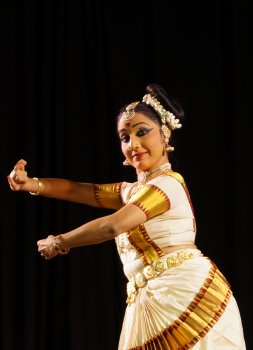 Neena Prasad The two evenings of the festival saw a total of six solo performances. Opening the first evening was Shagun Bhutani. One has seen Shagun as an excellent Chhau dancer in the past. Somehow her Odissi performance seemed to lack the lyrical refinement one expects from the dance form. She opened with a Pushpanjali followed by an invocation to the mother goddess. She continued into a pure dance sequence, the Arabhi Pallavi, a creation of Guru Kelucharan Mohapatra. A severe lack of confidence in her footwork and the required grace made her presentation a tedious effort to watch. What emerged was a visible disconnect with the energetic music on one side and the slack dance on the other side, which made the dance feel like it was a delayed feedback to the music. While one wouldn’t like to compare, the fact remains that one has seen Shagun put up a better show in Chhau, which really doesn’t match her flair for Odissi. It will take a while before Shagun can convince rasikas with her Odissi like she can with her Chhau. ‘Old and Upcoming’ was a title Shagun had mentioned during the morning seminar and that might sound apt for her without any conscious effort. The second performance was a more lively presentation of ‘Yagnaseni’, a pada varnam set to ragam Lathangi by Mohiniattam dancer Neena Prasad. Neena’s total involvement with the character, the sowkhyam in her abhinaya added to the melodious singing by Madhavan Nampoothri made it pleasurable to watch. Every time Madhavan sang the refrain ‘Sakhi Krishna Sakhi’ and Neena returned to the sthayi bhavam of her performance, a new mood was evoked from the narrative of Draupadi’s story. 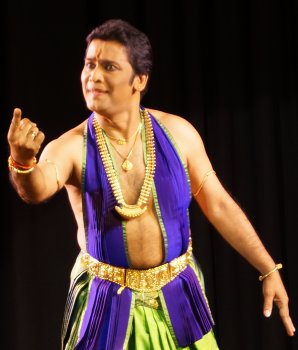 Lakshmanaswamy If one went by believing what Mridu Tripathi mis-announced, Lakshmanaswamy performed ‘Nee Saatea Dorrah.’ When will announcers learn to get their language skills right? That’s another story for another time. Lakshman’s performance of the varnam accompanied by some excellent music, especially the musical couple of Delhi – Sudha Raghuraman on vocals and G. Raghuraman on flute, set the mood going. Raghuraman’s flute created a new ambience in the hall with the Bhairavi ragam. The ‘virahothkanthika’ nayika pining for her lover, in this case King Serfoji II, and her being tormented by cupid’s arrows was dramatically executed by Lakshman. At one point, even Sudharma Vaidyanathan’s disturbing the singer didn’t deter her from continuing to render a phrase much like nothing could stop the nayika’s endless pining. A bhajan ‘Bhakta jana vatsale’ to which Lakshman did endless pirouettes became an anti-climax of sorts. One wishes he had ended his performance without it. The second evening’s performances began with a high-energy recital by Manipuri dancer Bimbavati Devi. If you have any preconceived notions about how slow, repetitive and on the verge of boredom Manipuri dance could be, Bimbavati was there to sweep away any of that with her performance. From her very entry, she stole the show. Opening with ‘Madhur Nartan’ and continuing into the rest of her items with movements inspired by Pung Cholom and Thang Tha, Bimbavati was a bundle of energy who kept her audience in rapt attention. With her mother Guru Kalavati Devi orchestrating the performance and Romila Devi’s high-pitched vocals filling the air, Bimbavati’s dance was a pleasure to watch even if one didn’t understand the intricacies of the Manipuri language. Raghuram’s melodious flute wafted us into the air of ragam Khamas before Priya Venkataraman’s performance. Ponnaiah Pillai’s famous pada varnam ‘Saamini Rammanave’ was elaborated. The nayika’s pining for lord Brihadeeshwara of Thanjavur being the main theme of the composition, Priya’s footwork and clarity of lines was commendable. What seemed to mar her performance was a constant, maybe unconscious twitching of an eyebrow and a pout that couldn’t be ignored. A little more effort in getting her mukhaabhinayam sorted would enhance her performances to a great extant. Thanks to Raghuraman’s flute, the music was tolerable despite vocalist G. Shrikant’s mispronouncing the sahityam. He seemed better in singing Sanskrit in the ashtapadi that Priya performed next. If he took the efforts to correct his Telugu language pronunciation, his good voice could add luster to a performance. 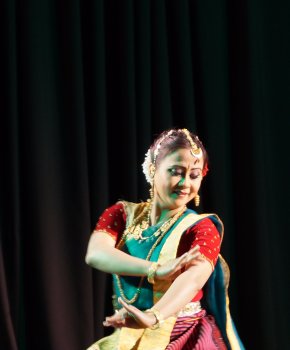 Bimbavati Devi 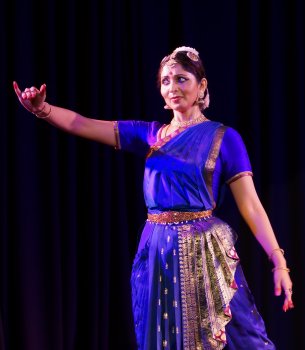 Priya Venkataraman 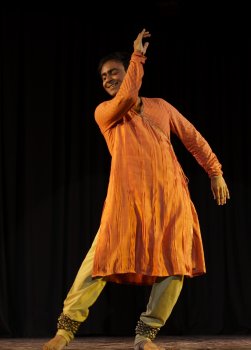 Prashant Shah 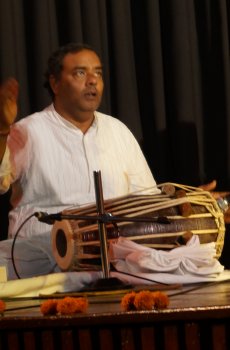 Ustad Fateh Singh Male Kathak dancers must know the art of changing the energy of a hall from Prashant Shah. He came already immersed in his mood to dance, stood in the stage center and one could hear all the voices in the hall reduce to murmurs and whispers. Launching into a series of upaj, toda, tukdas and padhants, Prashant exhibited his technical virtuosity on a stage that felt small for once. Ustad Fateh Singh’s outstandingly energetic pakhawaj boosted the performance further. Finishing his performance with a Thumri ‘Haari Main Tho Haari Giridhaari’ in raag Bhairavi composed by Atul Desai, Prashant’s attempt at abhinaya was well executed. While one couldn’t find the depth of poetry in a rather modern Thumri, like one does in the traditional lyrics of Maharaj Bindadin, the composition as such felt very common place. Prashant’s attempt in portraying abhinaya gave it a special flavour. His strength is in his abhinaya and he must work towards enhancing it and presenting more of it to his audiences. It might have been the stress of organizing that took a toll but dancers who organize aren’t really obliged to perform in their own festivals. The two-day festival highlighted a different facet of solo dances. One wonders why wasn’t a single Indian contemporary dance programmed into the festival when there are enough soloists there. For that matter Indian contemporary dance is as old as independent India, if not older. As poet critic Ashok Vajpeyi asked in his thought-provoking speech in the morning seminar, if classical music could survive in a solo format, what is obstructing dance from? Also, do all dancers qualify enough to become excellent soloists? Yes, not just good but uncompromisingly excellent. These are points dancers, organizers and dance enthusiasts need to think about seriously. Ek – Anant was certainly a great endeavor in helping shift focus to the solo dance tradition. Veejay Sai is a writer, editor and a culture critic. About the morning seminar of ‘Ek Anant’ In support of the solo - Lalitha Venkat |